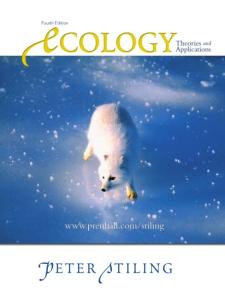Ecology Theories and Applications 4th Edition
Description
This substantially revised fourth edition brings to fore the fascinating aspects of ecology. As, an understanding of ecological principles is so essential for students as well as environmental scientists, this book provides a conceptual framework of ecology on which environmental science is based. A knowledge of such concepts enables one to take conservation measures and make attempts to restore the planet after the ravages of pollution. This edition has undergone major changes. The introduction has been completely rewritten to introduce the students to the discipline of evolutionary and behavioural ecology, population ecology, community ecology, and ecosystems ecology-the four pillars on which this book is built. The population ecology section continues its focus on factors affecting population growth; however, more attention has been devoted to mutualism and commensalism and to parasitism. While the format of the fourth edition remains similar to the third edition, with each chapter starting on an explanation of a concept followed by examples well illustrated with data, figures and tables, the pedagogical emphasis has been refocussed. For example, each chapter begins with a one-sentence outline on what each section in the chapter is about. Not only have a large number of diagrams but also some of colour photographs been added to illustrate the point of discussion. Finally, a summary at the end of each chapters recollect the major points and should prove to be an invaluable study aid. Students pursuing courses in environmental science which is increasingly being taught in universities across the country, and environmental scientists will find this in-depth study highly useful. Table of Contents I. INTRODUCTION. 1. Why and How to Study Ecology. What Is Ecology? Ecological Methods. Spatial Scale. II. EVOLUTION AND BEHAVIORAL ECOLOGY. 2. Genetics and Ecology. Evolutionary History. Genetic Mutation. Measuring Genetic Variation. Genetic Variation and Population Size. 3. Extinction. The Extinction Crisis. Patterns of Extinction. Endangered Species. Species Characteristics and Extinction. 4. Group Selection and Individual Selection. Group and Individual Selection. Altruism. Group Living. 5. Life History Strategies. Reproductive Strategies. Age Structure. Mating Systems. III. POPULATION ECOLOGY. 6. Population Growth. Life Tables. Reproductive Rate. Deterministic Models: Geometric Growth. Stochastic Models 7. Physical Environment. Physical Variables. Physical Factors and Species. Physical Factors and Numbers of Species. 8. Competition and Coexistence. Species Interaction. Intraspecific Competition. Interspecific Competition: Laboratory Experiments. The Frequency of Competition. Modeling Competition. Coexistence of Species. 9. Mutualism Plant-Pollinator Mutualism. Seed Dispersal. A Variety of Mutualisms. Modeling Mutualism. Mutualisms and Community Process. Commensalism. 10. Predation. Antipredator Adaptations. Predator-Prey Models. Field Studies of Predator-Prey. Introduced Predators. Field Experiments with Natural Systems. 11. Herbivory. Plant Defenses. Modeling Herbivory. Effects of Herbivores on Plants. Effects of Plants on Herbivores. Herbivory Affects Community Structure. 12. Parasitism. Defining Parasites. Defense against Parasites. Modeling Parasitism. Parasites Affect Host Populations. Parasites Affect Communities. Parasites and Biological Control. 13. Evaluating the Controls on Population Size. Comparing the Strengths of Mortality Factors. Density Dependence. Metapopulations. Conceptual Models of Population Control. IV. COMMUNITY ECOLOGY. 14. The Main Types of Communities. Are Communities More than the Organisms They Comprise? Climate and Community Structure. Classification of Communities. Terrestrial Communities. Aquatic Communities. 15. Global Patterns in Species Richness. Explanations of Species Richness Gradients. Community Similarity. Global Species Richness. Preserving Species Richness. Species Richness and Community Function. 16. Species Diversity. Diversity Indices. Rank Abundance Diagrams. Community Similarity. Cluster Analysis. 17. Stability, Equilibrium, and Nonequilibrium. Community Stability. Is There a Link between Diversity and Stability? Experimental Tests of the Diversity-Stability Hypothesis. The Intermediate-Disturbance Hypothesis. 18. Succession. Development of Communities. Facilitation. Inhibition. Tolerance and Other Patterns of Succession. Patterns in Species Richness during Succession. Biotic Interactions and Succession. 19. Island Biogeography. Theory of Island Biogeography. Species-Area Effects. The Effect of Distance on Island Immigration. Species Turnover. 20. Trophic Structure. Food Web Complexity. Food Web Patterns. Problems with Food Web Patterns. Guilds. Keystone Species. 21. Energy Flow. Measuring Production. Limits to Primary Production. Patterns in Primary Production. Secondary Production. The Limits to Secondary Production. 22. Nutrients. Soils. Nutrient Availability. Light. Organismal Effects on Nutrient Availability. Glossary. Literature Cited. Photo Credits. Index.
Last updated on
Product Details
- Prentice Hall of India Brand
- 8120321316 ISBN-10:
- 9788120321311 ISBN-13:
- 013091102X Contents same as book with ISBN
- 1100.0 pages Paperback
- International Edition Media
- 1 lb Weight:




